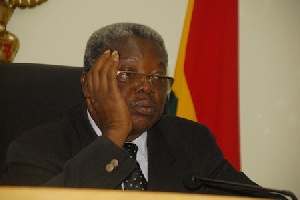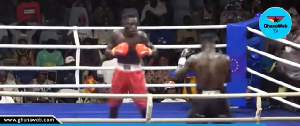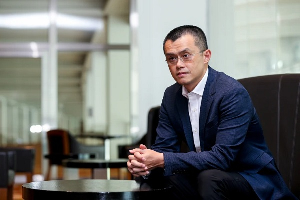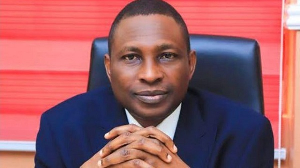- Home - News
- TWI News | TV
- Polls
- Year In Review
- News Archive
- Crime & Punishment
- Politics
- Regional
- Editorial
- Health
- Ghanaians Abroad
- Tabloid
- Africa
- Religion
- Election 2020
- Coronavirus
- News Videos | TV
- Photo Archives
- News Headlines
- Press Release
General News of Thursday, 11 September 2014
Source: Daily Guide
Worawora Chief claimed Ghc428,000 compensation
Even though Worawora was not part of communities listed to be paid compensation in the Volta Basin Flooded Area, the Paramount Chief of the area, nana Asare Baah III, was able to collect Ghc428,240 from government.
Nana Asare Baah III, Omanhene of Worawora and a practicing barrister, yesterday justified the payment at the Commission of Enquiry investigating the payment of judgement debts.
He admitted he was paid Ghc429,530.00 (which appeared in the commission’s record as Ghc428,240.00) and said about 3,066 acres of Worawora lands were flooded when the Akosombo Hydro Electric Dam was constructed in the 1960s.
He told Sole-Commissioner Justice Yaw Apau that he has been a chief of Worawora for the past 36 years, adding that it was his predecessor who initiated the claim for the compensation and he had to follow it up to its logical conclusion.
He said Worawora lands came into the picture when the people of Pai included their lands in their pursuit for compensation, saying, “we had to fight to get it back and my land was the smallest among the claims.”
When the Sole-Commissioner asked him why the initial claim was in the name of the Worawora Stool instead of the individual families as admitted, the witness said the first chief might have made a mistake.
Nana Asare Baah admitted that the amount was paid into his personal account before it was forwarded to the family heads. But he was quick to point out that one-third of the amount was used by the Worawora Stool for development.
“I have documents to show how the money was paid into my account and later shared among the family heads, but I do not have documents on how it was distributed among them because I was not in the country at that time.”
Nana Danagigy, Chief of Tankreku, which is part of Nchumuru but placed under the Krachi Traditional Council, told the commission that all their lands were submerged following the construction of the dam.
He said the VRA settled the people of Tankreku in Grubi and got them very little communal lands for farming, but did not give them compensation for their crops.
However, the commission’s counsel, Dometi Kofi Sorkpor, insisted that the leaders of the town collected Ghc86,230.00 as compensation in 1975.
The witness admitted that he collected Ghc159,321.04, in six tranches, for 3,743.31 acres of land destroyed by the floods for the people of Tankreku, but the records showed that the site plan was in his name.
Cabinet, in July 2008, approved a consolidated amount of compensation totalling Ghc138 million for various stools/families in Pai, Apaaso, Makango, Ahmandi and Kete Krachi Traditional Areas.
About 57 groups were said to have benefited from the amount.
Records at the commission revealed that Ghc71 million has so far been paid to the various claimants, but the disbursement of the remaining Ghc67 million has been put on hold to enable the government deal with discrepancies in the payments.
Some of the witnesses appearing before the Sole-Commissioner have been tendering in evidence site plans that did not have dates embossed on them, but had purportedly been used to claim the said amounts from the Lands Commission.
Justice Apau even expressed shock at how the Lands Commission could have proceeded to order the release of the various amounts to the claimants based on the documents the witnesses tendered before the commission.
Furthermore, the Court of Appeal judge did not understand why communities that were resettled by the government in the 1960s, given communal lands and paid compensation for crops destroyed by the Volta River floods could turn around to claim cash compensation almost 50 years down the line.











